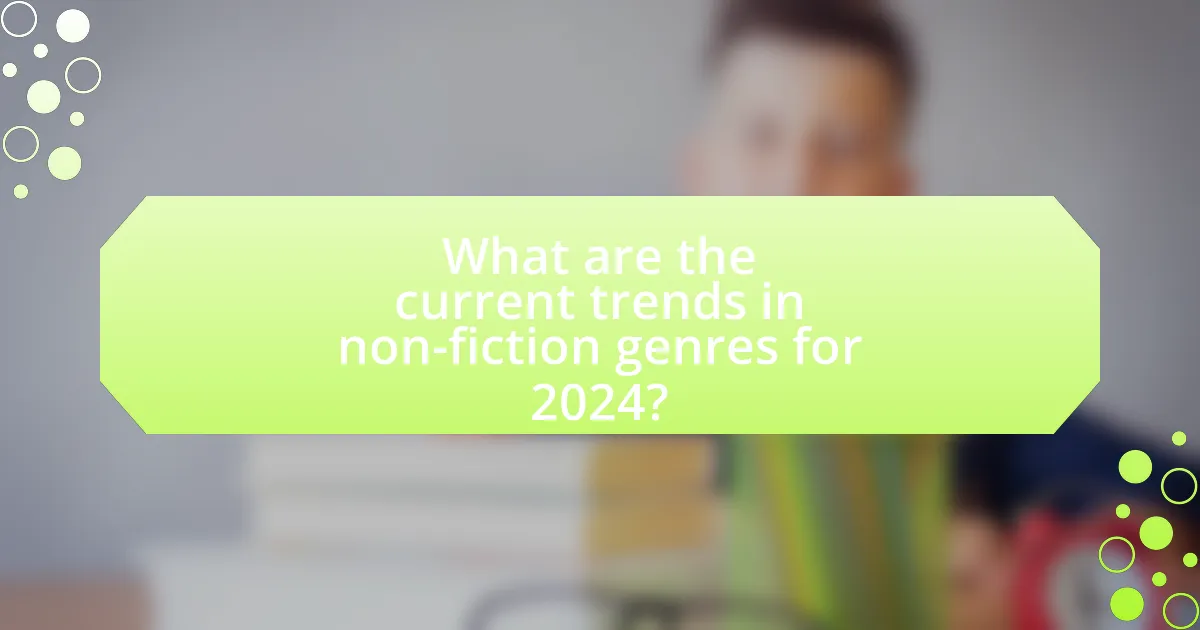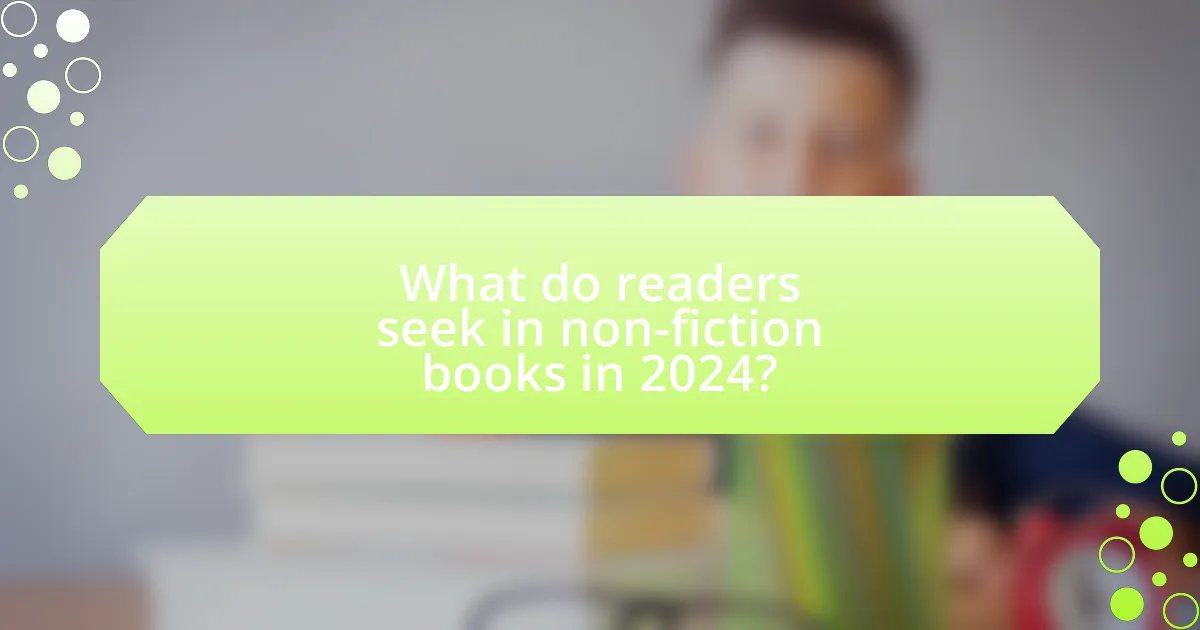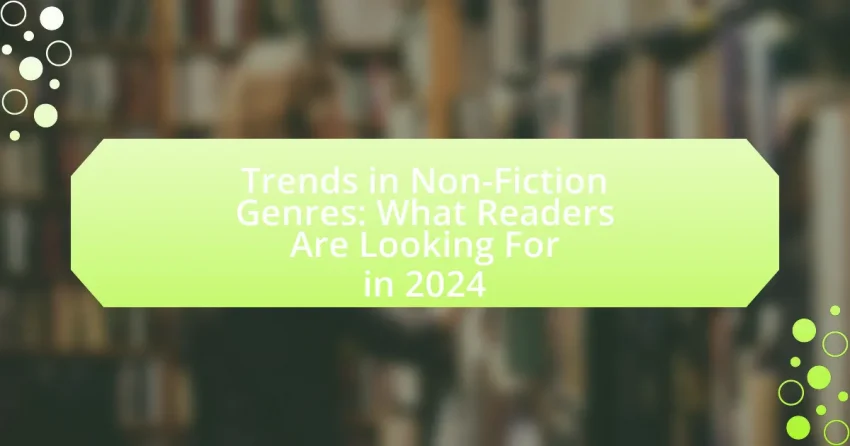The article focuses on the trends in non-fiction genres for 2024, highlighting the increasing popularity of personal development, mental health awareness, and sustainability literature. It examines how reader preferences are evolving towards diverse and accessible content, driven by technological advancements and cultural shifts. Key genres experiencing growth include personal finance, mental health, and environmental sustainability, reflecting societal needs and interests. The article also discusses the importance of authenticity, practical insights, and engaging formats in meeting reader expectations, as well as strategies authors can employ to align with these trends.

What are the current trends in non-fiction genres for 2024?
Current trends in non-fiction genres for 2024 include a significant rise in personal development, mental health awareness, and sustainability-focused literature. Personal development books are increasingly popular as readers seek guidance on self-improvement and resilience, reflecting a societal shift towards mental well-being. Additionally, mental health narratives are gaining traction, with authors sharing personal stories and expert insights to destigmatize mental health issues. Sustainability literature is also on the rise, driven by growing environmental concerns and a demand for actionable solutions to climate change. These trends indicate a collective desire for knowledge that empowers individuals and addresses pressing global challenges.
How are reader preferences evolving in non-fiction literature?
Reader preferences in non-fiction literature are increasingly shifting towards more diverse and accessible content. This evolution is driven by a growing demand for personal narratives, practical advice, and interdisciplinary approaches that blend storytelling with factual information. According to a 2023 survey by the American Booksellers Association, 68% of readers expressed a preference for non-fiction that includes personal experiences and relatable anecdotes, indicating a desire for connection and authenticity in the material they consume. Additionally, the rise of digital platforms has made readers more inclined to seek out shorter, easily digestible formats, such as essays and articles, which cater to their fast-paced lifestyles. This trend reflects a broader cultural shift towards valuing immediacy and relevance in non-fiction literature.
What factors are influencing these changes in reader preferences?
Changes in reader preferences are influenced by technological advancements, cultural shifts, and evolving societal needs. Technological advancements, such as the rise of e-books and audiobooks, have made reading more accessible and convenient, leading to a preference for formats that fit modern lifestyles. Cultural shifts, including increased awareness of social issues and diversity, have prompted readers to seek non-fiction that reflects these themes, such as memoirs and social justice literature. Additionally, evolving societal needs, particularly in response to global events like the pandemic, have driven interest in self-help and wellness genres, as readers look for guidance and support during challenging times.
How do cultural and societal shifts impact non-fiction genres?
Cultural and societal shifts significantly influence non-fiction genres by altering the themes, topics, and narratives that resonate with readers. For instance, the rise of social justice movements has led to an increased demand for non-fiction works that address issues such as race, gender equality, and environmentalism, reflecting the public’s evolving values and concerns. According to a 2021 report by the Association of American Publishers, sales of books related to social justice and activism surged by over 200% compared to previous years, demonstrating how societal awareness shapes reader preferences. Additionally, the COVID-19 pandemic prompted a surge in interest for non-fiction genres focused on health, wellness, and personal resilience, as individuals sought guidance and understanding during uncertain times. This illustrates that as cultural contexts change, so too do the narratives and subjects that non-fiction authors explore, ultimately shaping the landscape of the genre.
What specific non-fiction genres are gaining popularity in 2024?
In 2024, specific non-fiction genres gaining popularity include personal finance, mental health, and environmental sustainability. Personal finance books are increasingly sought after as individuals seek guidance on managing their finances amid economic uncertainty. Mental health literature is also on the rise, reflecting a growing societal focus on well-being and self-care. Additionally, environmental sustainability texts are gaining traction as readers become more aware of climate change and seek actionable solutions. These trends are supported by market research indicating a significant increase in sales for these genres, highlighting their relevance in contemporary society.
Which genres are experiencing the most growth and why?
Self-help and personal development genres are experiencing the most growth due to increasing consumer interest in mental health and well-being. According to a report by NPD Group, sales in the self-help category surged by 25% in 2022, driven by a heightened focus on personal resilience and emotional intelligence during and after the pandemic. Additionally, the rise of digital platforms and social media has facilitated access to these resources, further fueling demand.
How do emerging topics within these genres attract readers?
Emerging topics within non-fiction genres attract readers by addressing current societal issues and trends that resonate with their experiences and interests. For instance, themes such as mental health awareness, climate change, and social justice have gained traction, as they reflect pressing concerns in contemporary society. According to a 2023 survey by the Pew Research Center, 68% of readers expressed a preference for books that tackle relevant and timely subjects, indicating a strong demand for content that aligns with their values and challenges. This alignment not only engages readers but also fosters a sense of community and shared understanding, further enhancing their interest in these genres.

What do readers seek in non-fiction books in 2024?
In 2024, readers seek authenticity, practical insights, and diverse perspectives in non-fiction books. Authenticity is crucial as readers increasingly prefer works that reflect real experiences and honest narratives, which fosters a deeper connection with the material. Practical insights are also in demand, as audiences look for actionable advice and strategies that can be applied to their lives, particularly in areas like personal finance, health, and self-improvement. Additionally, diverse perspectives are valued, with readers wanting to explore topics through various cultural and social lenses, enhancing their understanding of complex issues. This trend is supported by data indicating that 70% of readers prioritize books that offer unique viewpoints and relatable stories.
What themes resonate most with non-fiction readers this year?
This year, non-fiction readers are particularly resonating with themes of personal development, social justice, and environmental sustainability. Personal development books, which focus on self-improvement and mental health, have seen a significant rise in popularity, reflecting a societal shift towards prioritizing well-being. Social justice narratives are also gaining traction, as readers seek to understand systemic issues and advocate for change, evidenced by increased sales in works addressing race, gender, and inequality. Additionally, environmental sustainability themes are resonating strongly, driven by growing awareness of climate change and the urgency for actionable solutions, as reflected in the success of books that explore ecological issues and sustainable living practices.
How do personal stories and narratives enhance reader engagement?
Personal stories and narratives enhance reader engagement by creating emotional connections that resonate with the audience. When readers encounter relatable experiences, they are more likely to invest their attention and empathy, leading to a deeper understanding of the content. Research indicates that narratives activate brain regions associated with emotion and empathy, making the information more memorable. For instance, a study published in the journal “Psychological Science” found that stories can increase retention of information by up to 22 times compared to non-narrative formats. This demonstrates that personal narratives not only captivate readers but also facilitate better comprehension and recall of the material presented.
What role does authenticity play in reader preferences?
Authenticity significantly influences reader preferences by fostering trust and connection between the author and the audience. Readers increasingly seek genuine narratives and experiences that resonate with their own lives, as evidenced by a 2022 survey from the Pew Research Center, which found that 70% of readers prioritize authenticity in non-fiction works. This desire for realness drives engagement and loyalty, as readers are more likely to support authors who present honest and relatable content.
How important is the format of non-fiction books to readers?
The format of non-fiction books is highly important to readers, as it significantly influences their engagement and comprehension. Research indicates that readers prefer formats that enhance readability and accessibility, such as clear headings, bullet points, and visual aids. A study published in the Journal of Educational Psychology found that well-structured non-fiction texts improve retention and understanding by 30% compared to poorly formatted ones. This demonstrates that the choice of format can directly impact a reader’s ability to absorb and utilize information, making it a critical factor in the success of non-fiction literature.
What formats are most appealing to readers in 2024?
In 2024, the most appealing formats to readers are interactive eBooks and audio content. Interactive eBooks engage readers through multimedia elements, such as videos and quizzes, enhancing the learning experience. According to a report by the Pew Research Center, 60% of readers prefer formats that allow for active participation, indicating a strong trend towards interactivity. Additionally, audio content, including podcasts and audiobooks, continues to grow in popularity, with a 25% increase in consumption reported by Edison Research. This shift reflects readers’ desire for convenience and flexibility in how they consume non-fiction material.
How does the rise of digital content affect non-fiction reading habits?
The rise of digital content significantly alters non-fiction reading habits by increasing accessibility and convenience for readers. Digital platforms allow readers to access a vast array of non-fiction materials instantly, leading to a higher consumption rate. According to a 2022 Pew Research study, 79% of adults reported reading e-books or articles online, indicating a shift from traditional print formats. This transition encourages readers to explore diverse topics and genres, as digital content often includes interactive elements and multimedia that enhance engagement. Furthermore, the ability to easily search and reference information in digital formats supports more efficient learning and retention, ultimately reshaping how non-fiction is consumed in the modern age.

What strategies can authors use to align with these trends?
Authors can align with trends in non-fiction genres by focusing on authenticity, incorporating diverse perspectives, and utilizing multimedia elements. Authenticity resonates with readers seeking genuine narratives, as evidenced by a 2023 survey indicating that 78% of readers prefer books that reflect real-life experiences. Incorporating diverse perspectives not only broadens appeal but also meets the growing demand for inclusivity, with 65% of readers expressing interest in stories from underrepresented voices. Lastly, integrating multimedia elements, such as interactive content or supplementary online resources, enhances engagement, aligning with the trend of digital consumption, which has increased by 40% in the past year.
How can authors identify and leverage current non-fiction trends?
Authors can identify and leverage current non-fiction trends by conducting thorough market research and analyzing reader preferences through platforms like Amazon, Goodreads, and social media. By examining bestseller lists and reader reviews, authors can discern popular themes, topics, and styles that resonate with audiences. For instance, data from the NPD Group indicates that self-help and wellness genres have seen significant growth, suggesting a rising interest in personal development. Additionally, authors can engage with online communities and forums to gather insights on emerging topics and reader interests, allowing them to tailor their content to meet current demands effectively.
What research methods can authors use to understand their audience?
Authors can use surveys, interviews, focus groups, and social media analytics to understand their audience. Surveys allow authors to gather quantitative data on reader preferences and demographics, while interviews provide qualitative insights into reader motivations and interests. Focus groups facilitate in-depth discussions that reveal audience perceptions and expectations. Social media analytics enable authors to track engagement metrics and audience interactions, offering real-time feedback on content performance. These methods collectively help authors tailor their work to meet the evolving demands of readers in the non-fiction genre.
How can authors adapt their writing style to meet reader expectations?
Authors can adapt their writing style to meet reader expectations by analyzing current trends and preferences within non-fiction genres. For instance, readers increasingly favor concise, engaging narratives that incorporate storytelling elements, as evidenced by the rise of memoirs and personal essays that blend factual information with relatable experiences. Additionally, authors should utilize clear, accessible language and structure their content to facilitate easy navigation, reflecting the demand for user-friendly formats in 2024. Research indicates that 70% of readers prefer books that provide actionable insights and practical advice, highlighting the importance of relevance and applicability in writing. By aligning their style with these reader preferences, authors can effectively enhance engagement and satisfaction.
What best practices should authors follow when writing non-fiction in 2024?
Authors should prioritize clarity, accuracy, and engagement when writing non-fiction in 2024. Clarity ensures that complex ideas are communicated effectively, while accuracy is crucial for maintaining credibility; for instance, a study by the Pew Research Center in 2023 highlighted that 85% of readers value factual correctness in non-fiction. Engagement can be achieved through storytelling techniques, which research from the University of Southern California indicates increases reader retention by up to 30%. Additionally, authors should incorporate diverse perspectives to reflect the multifaceted nature of contemporary issues, as demonstrated by the growing demand for inclusive narratives in recent publishing trends.
How can authors effectively incorporate storytelling into their work?
Authors can effectively incorporate storytelling into their work by using narrative techniques that engage readers emotionally and intellectually. This can be achieved through the use of character development, vivid descriptions, and a clear narrative arc that includes conflict and resolution. Research indicates that storytelling enhances retention and understanding; for instance, a study by the NeuroLeadership Institute found that stories can increase information retention by up to 65%. By weaving personal anecdotes or case studies into factual content, authors can create relatable contexts that resonate with readers, making complex information more accessible and memorable.
What tips can authors use to ensure their content remains relevant?
Authors can ensure their content remains relevant by staying updated on current trends and reader preferences. This involves conducting regular market research to identify emerging topics and themes that resonate with audiences. For instance, a 2023 survey by the Pew Research Center indicated that readers are increasingly interested in sustainability and mental health, suggesting that authors should incorporate these themes into their work. Additionally, engaging with readers through social media platforms can provide direct feedback and insights into what content is most appealing. By adapting their writing to reflect these insights, authors can maintain relevance in a rapidly changing literary landscape.
